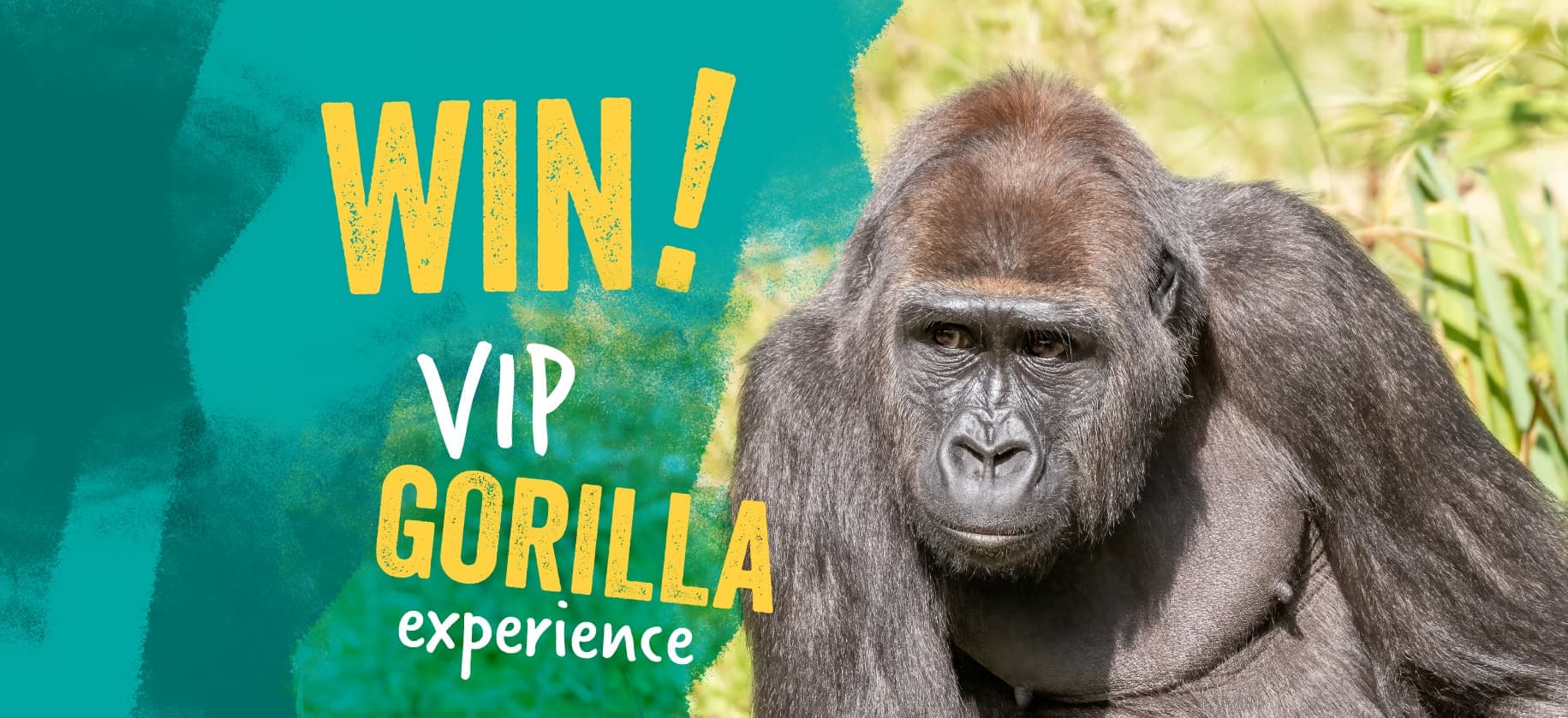
A day in the life of a gorilla at Bristol Zoo
Posted on: 28 August, 2025
In our most recent blogs, we introduced you to our troop and dived into the truly fascinating behaviour of each individual. Here, we're revealing what a day in the life of a gorilla looks like at Bristol Zoo, highlighting even more unique quirks of each member of the family group.
Our wonderful team of Animal Keepers work alongside the troop every day at the former Bristol Zoo Gardens site, and are a fountain of knowledge when it comes to the species and their care.
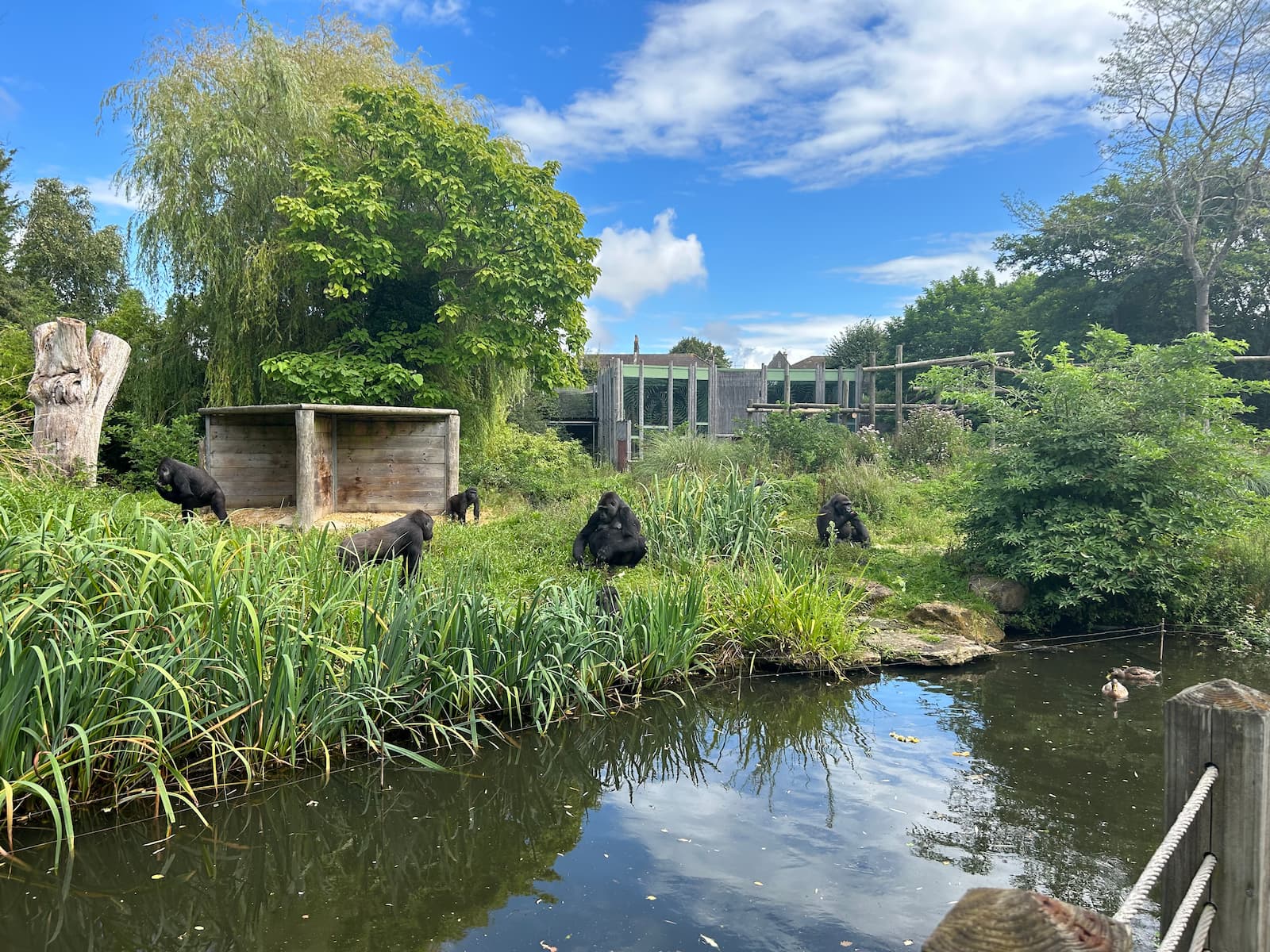 As the sun rises at Bristol Zoo Gardens, the gorillas awaken from their nests. The lighting system of their house mimics the sunrise outside, gradually phasing brightness throughout. Mother and babies – Touni and Juni, Kera and Hasani – emerge from the same big nests, whereas the others all have their own. Kala particularly loves a big fluffy nest, and Jock usually steals somebody else’s, or he will sleep on the floor. In the wild, silverbacks generally sleep at ground level so they can maintain visual contact with other members of the group. Due to their size, silverbacks are also not as skilled at tree climbing in comparison to females and youngsters. In general, silverbacks aren't the most intricate of nest builders, so it's often easier for them to displace somebody else and steal theirs than make their own.
As the sun rises at Bristol Zoo Gardens, the gorillas awaken from their nests. The lighting system of their house mimics the sunrise outside, gradually phasing brightness throughout. Mother and babies – Touni and Juni, Kera and Hasani – emerge from the same big nests, whereas the others all have their own. Kala particularly loves a big fluffy nest, and Jock usually steals somebody else’s, or he will sleep on the floor. In the wild, silverbacks generally sleep at ground level so they can maintain visual contact with other members of the group. Due to their size, silverbacks are also not as skilled at tree climbing in comparison to females and youngsters. In general, silverbacks aren't the most intricate of nest builders, so it's often easier for them to displace somebody else and steal theirs than make their own.
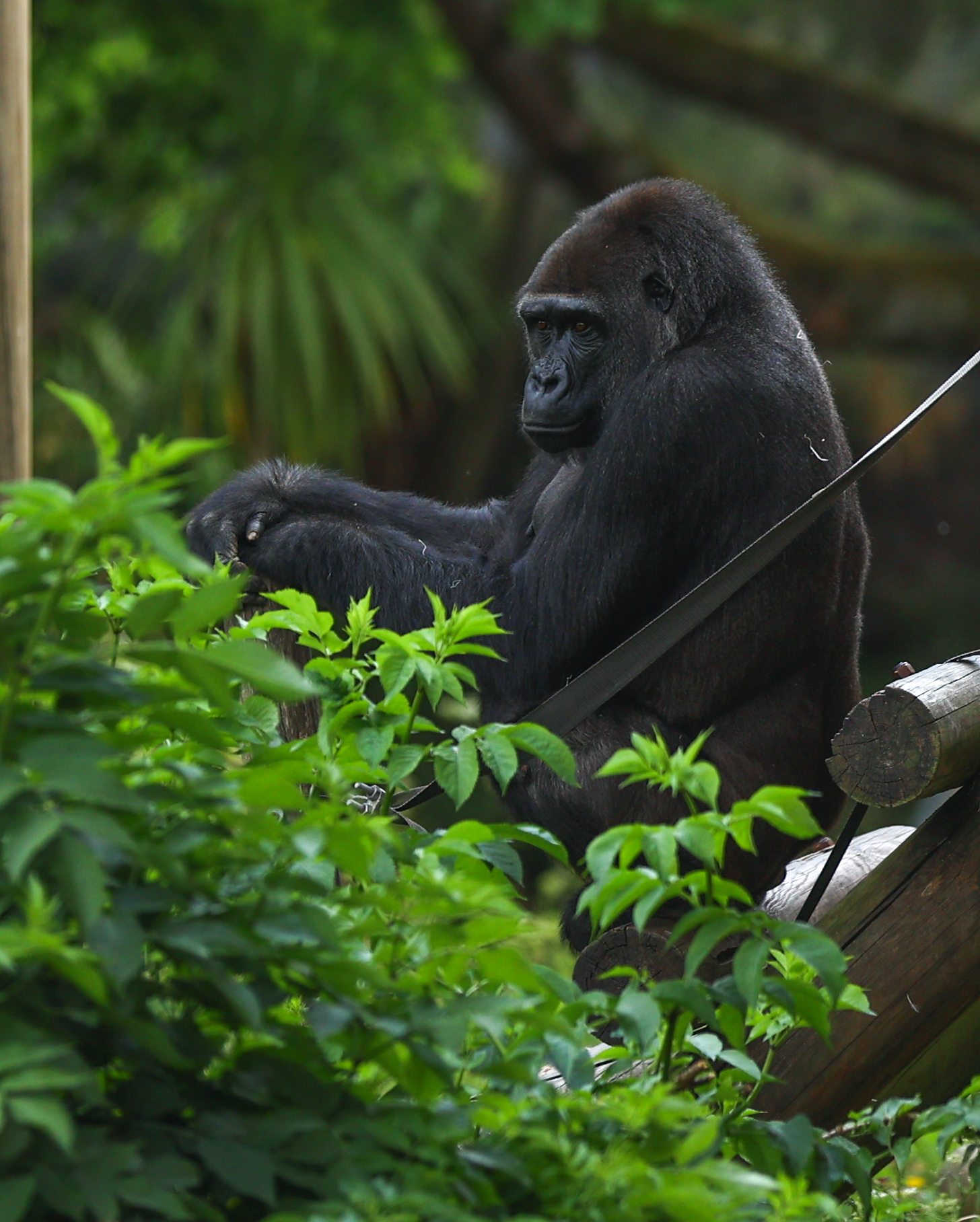 Photo credit: Verity McGuire
Photo credit: Verity McGuire
Once awake, the troop tend to mill around the house looking for browse left over from the previous day or will often go outside in the warmer months to pull up grass and forage for other bits of food from the island.
The keepers prepare breakfast first thing in the morning and chop up two large crates' worth of vegetables, as well as weigh out pellets. If the weather's nice, they'll spread it far and wide across the island, but if it's not so nice, they’ll scatter the food all around their house so that the gorillas must climb and balance on ropes and the climbing frame to access the food. This encourages the natural foraging techniques of reaching ripe fruit in trees in the wild.
As the gorillas tuck into their first feast of the day, the keepers get to work cleaning their house, which takes around three hours each morning. Gorillas typically poo everywhere, including in their nests, which is also seen in wild populations, as they move on to a new nest site each day and don’t need to worry about cleanliness. The keepers removing poo and tidying up the nests is equivalent to the gorillas encountering new nest sites in the wild.
During this time, the gorillas continue to have access to both their indoor and outdoor areas, and are encouraged to move between the indoor dens thanks to a second breakfast of browse so the keepers can clean. This includes a variety of different branches and leaves, including bramble, hazel and lime, to name a few. They're also given lucerne fodder, also known as alfalfa, which is a high-protein forage crop.
Win a VIP Gorilla Keeper Experience!
Enter from just £5 and you could win one of two unique Gorilla Keeper Experiences at Bristol Zoo Project, while supporting our African Forest Appeal!
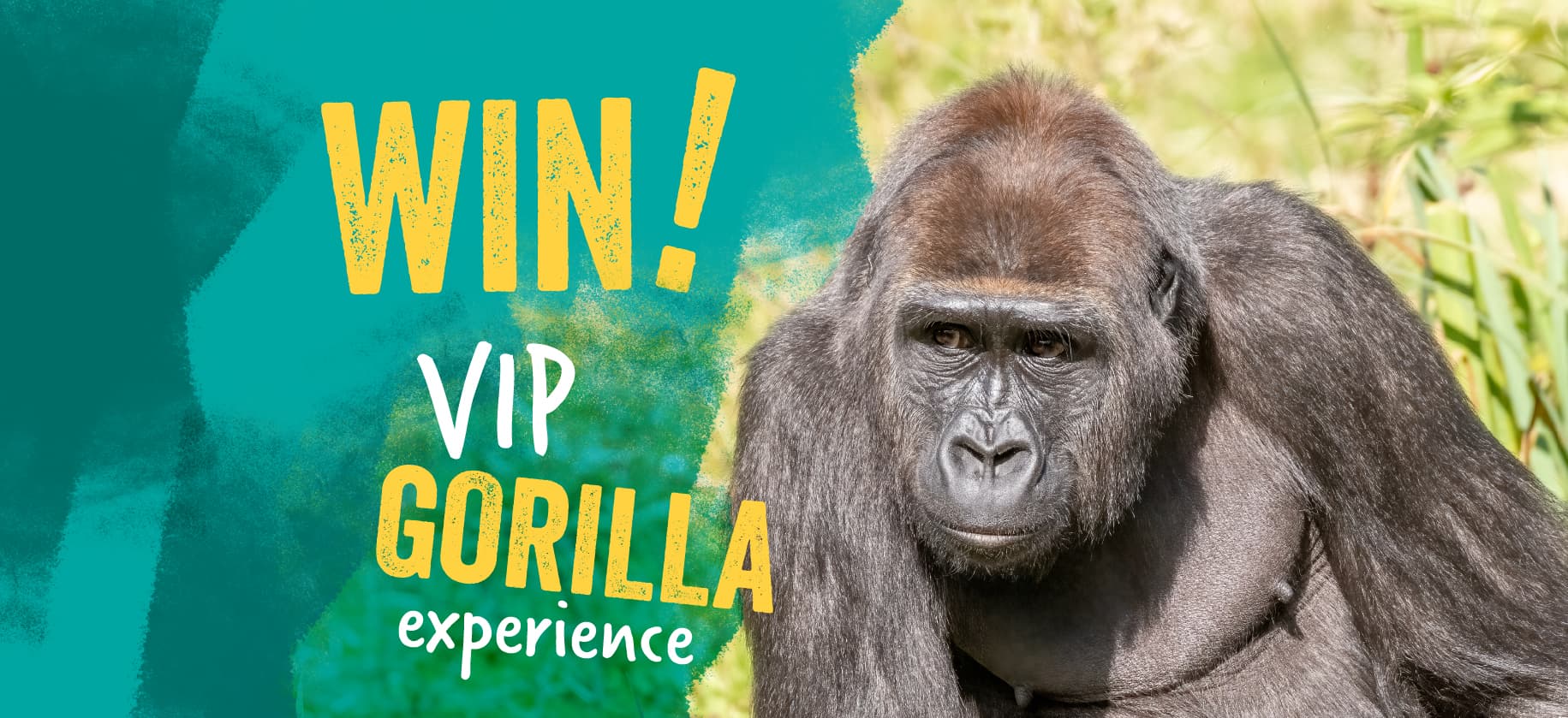
The second breakfast provides the perfect opportunity for enrichment, as foods are inserted into different puzzle feeders and slow feeding devices to encourage them to use their problem-solving skills to access it. It's well documented that gorillas living in the wild create and use tools to access food, and our group are no different. They can often be seen shaping sticks and using them to scoop and prod to access tasty treats.
The approach to enrichment can differ hugely between individuals. For example, Kera and Afia are excellent at using tools and mastering their techniques. Kala tends to hit it and hope, whereas Jock, on the other hand, has no patience for problem-solving, so if the food isn’t easily accessible, he doesn’t bother! The keepers always make sure he gets his share if he ignores the enrichment, though. Hasani has quickly watched and copied the techniques of his surrogate mum, Kera, and has become particularly good at using tools.
The troop aren’t only provided with food-based enrichment; they are also given novel items, such as paper sacks, hessian sacks, and old sheets which they like to play with. Having taken quite the shine to paper sacks in particular, they'll often incorporate these into their play displays by beating their chests while holding the sack which makes a loud rustling noise. In the hot weather, the keepers will also create a small pool of cool water inside for them to paddle and play in. Juni and Hasani particularly like splashing around in the shallow water, while Kala and Kera like to swipe an armful of water at each other for their own amusement!
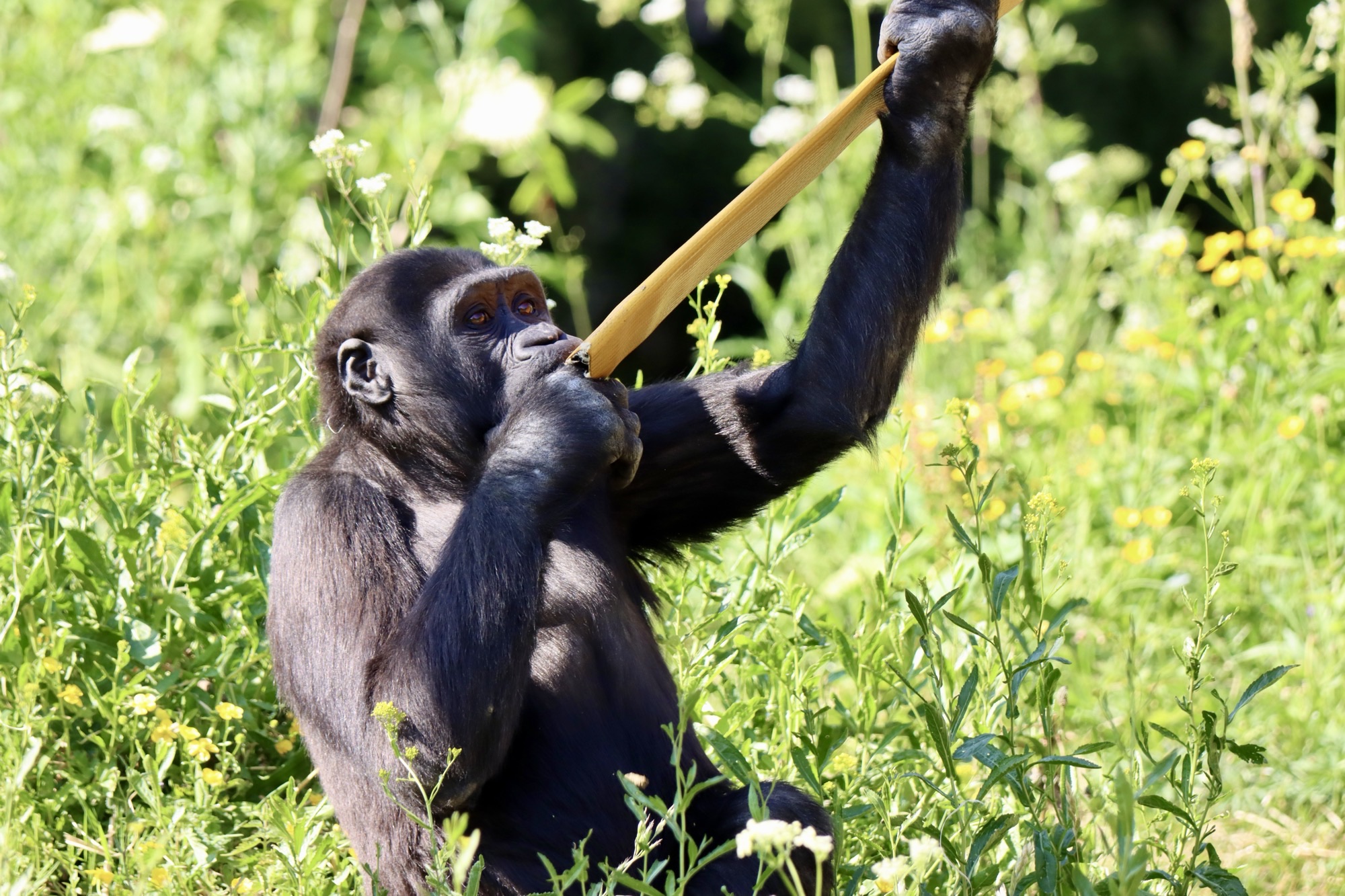 Photo Credit: Corey Hawkins
Photo Credit: Corey Hawkins
After breakfast, the group tend to settle down for a nap together. They'll gather heaps of bedding and decide where they fancy a nap. The sub-adults like to sleep fairly close to Jock, and the other group members tend to organise themselves in the same den as Jock.
It's typically during these rest periods, as the troop are settling down to snooze, when their social behaviours are seen. The babies will be racing around wrestling while the adults are trying to sleep, or they'll try to entice their mums and siblings to play. Sometimes related individuals will use this time to groom each other, also known as allogrooming, and on extremely rare occasions, the unrelated females might groom each other, but this is not typical.
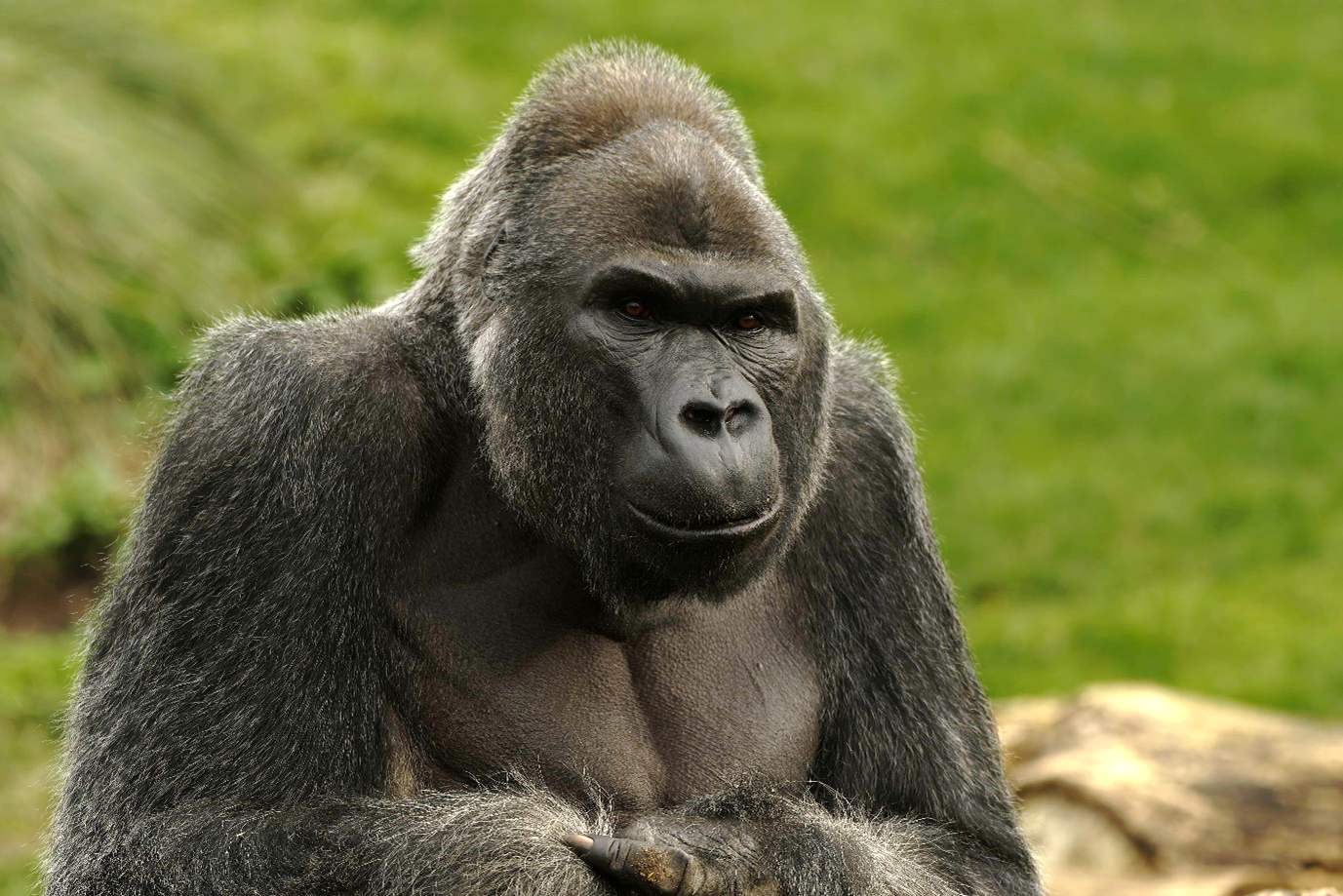 Photo credit: Katie Horrocks
Photo credit: Katie Horrocks
Once they wake up from their mid-morning nap, the keepers usually do a training session with Jock. They're currently working towards regular downloads of the data stored on his ILR implant, which is a heart recording device. Jock is a geriatric silverback at 42 years old, so monitoring his cardiac health is very important. The data stored on the implant is shared directly with the Great Ape Heart Project, who have a long running study on great ape heart health, so we can further our knowledge on apes living in zoos and how to elevate their welfare. The team also use this time to conduct a visual health check on Jock, looking inside his mouth to assess dental health, the underside of his feet, and checking his hands and fingers for any injuries he may have sustained keeping his unruly family in check.
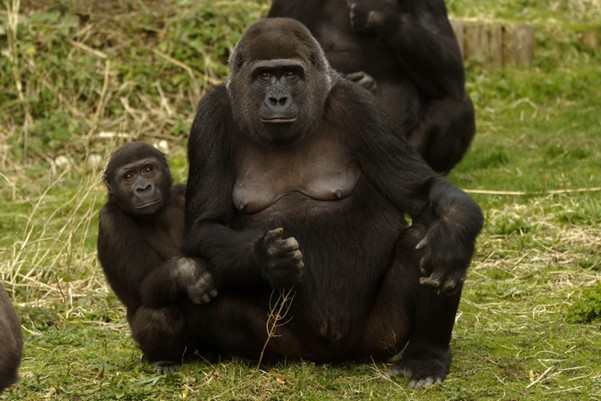 Photo credit: Katie Horrocks
Photo credit: Katie Horrocks
After this, the troops enjoys another scatter feed on the island together. The frequency of feeds for the gorillas aims to echo the amount of time they spend foraging in the wild. Typically, wild gorillas spend the majority of their day foraging, and we seek to provide them with the same opportunity. During the lunch feed, the kids – Juni and Hasani – have to be pretty savvy and eat at a safe distance from their mums, Touni, Kala, and Kera, who may seek to steal it. Infant Juni likes to lurk behind Jock and stare longingly at his food, hoping Jock may look away for a second so he can steal something and run away!
After this, you guessed it...another nap!
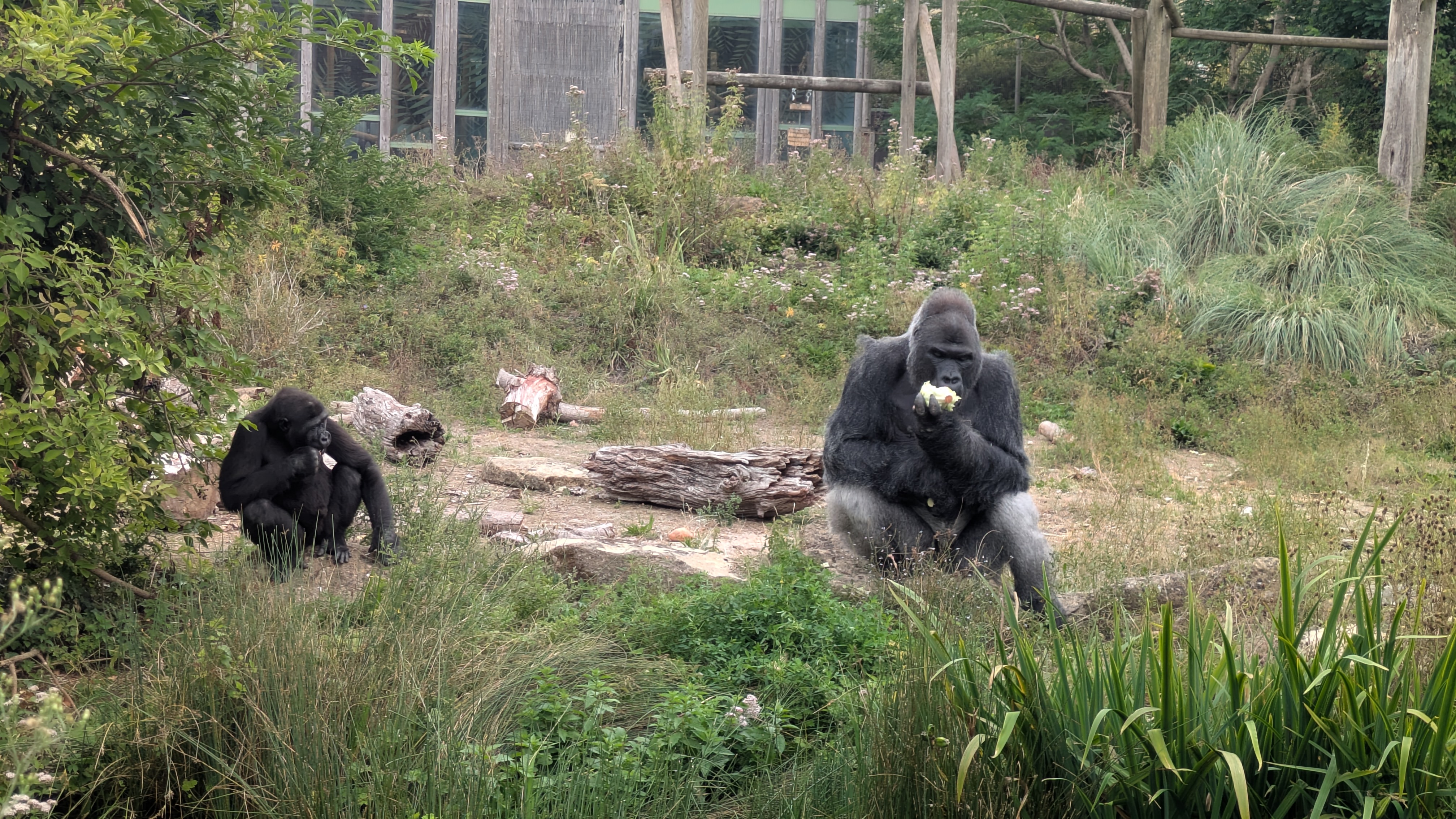 Mid-afternoon is time for the denning routine. Every gorilla has their own management den, and the keepers have established a routine to enable each gorilla to sit in their den in peace and eat their own individual bucket of vegetables. The amount of vegetables is tailored per gorilla according to age and body weight. Jock, as expected, has an enormous diet, consuming just over 10kg of vegetables a day, but the younger adults and juveniles also have pretty large diets as they are still growing.
Mid-afternoon is time for the denning routine. Every gorilla has their own management den, and the keepers have established a routine to enable each gorilla to sit in their den in peace and eat their own individual bucket of vegetables. The amount of vegetables is tailored per gorilla according to age and body weight. Jock, as expected, has an enormous diet, consuming just over 10kg of vegetables a day, but the younger adults and juveniles also have pretty large diets as they are still growing.
This is a nice opportunity for the less dominant individuals to sit and eat without having to worry that they may be displaced or have their food stolen. Jock particularly enjoys this part of the day without the kids buzzing around him, looking longingly at his pile of food. They all sing and grumble in their dens as they tuck into their food, and each individual has their own voice and song that keepers can recognise. Juni and Hasani have their own dens next to their mums, but we leave a juvenile-sized gap in the diving slide so they can join mum if they want to. Once they're done eating their vegetables, the keepers carry out individual training sessions and health checks. For some of our gorillas, this now also involves crate training in preparation for the big move to their new habitat at Bristol Zoo Project.
After this, the gorillas are mixed back together and they mill around each other’s dens, munching on leftovers. While they're doing this, keepers will tidy up the island and put a scatter of herbs outside. The troop particularly loves chives! We also often put more enrichment out on the island for them to gather up and they regularly stay outside after the herbs are gone so they can forage for more grass and wildflowers.
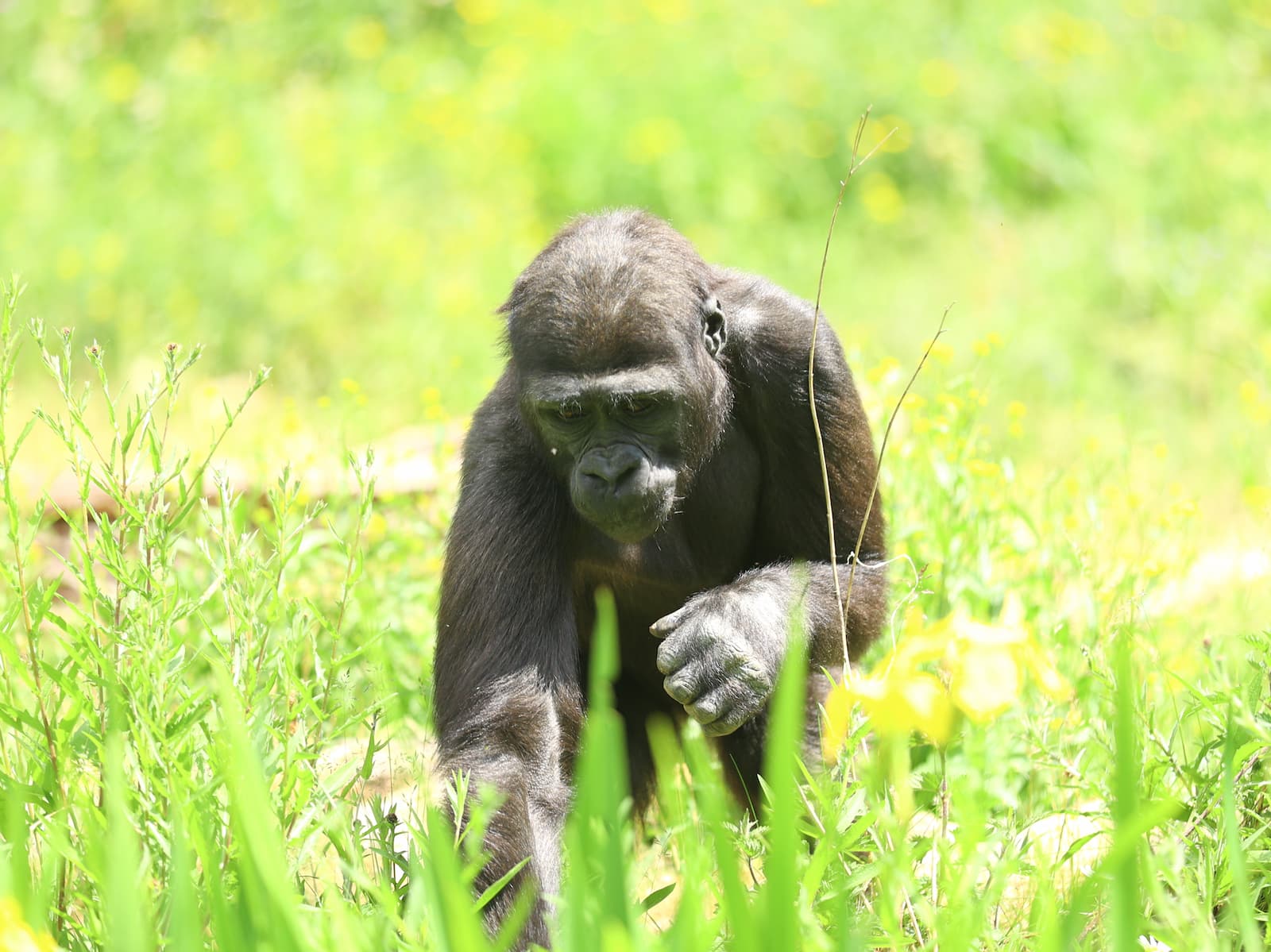 Photo credit: Verity McGuire
Photo credit: Verity McGuire
The troop typically go to bed as the sun goes down, and the lighting system follows the same system as it does in the morning, gradually fading off with the sunset. Once again, they will gather nesting materials and settle down to snooze.
For over 90 years, Bristol Zoological Society has been dedicated to the care of gorillas, playing a vital role in the European captive breeding programme and supporting efforts to protect the future of this critically endangered species.
Currently living at Bristol Zoo Gardens, our troop of western lowland gorillas will relocate to the new African Forest habitat at Bristol Zoo Project later this year, where they'll be introduced to a new group of Endangered cherry-crowned mangabeys that will live alongside them. The habitat will also be home to Critically Endangered slender-snouted crocodiles, Endangered African grey parrots, and several extremely threatened species of West African freshwater fish, and has been designed to closely reflect their natural habitats, including a natural forest canopy that reflects the dense forests of Equatorial Guinea.
You can find out more information about our gorilla troop in the following blogs:
Meet the troop - a guide to our gorillas,
What we feed our gorillas at Bristol Zoo,
The fascinating behaviour of our gorilla troop,
7 fascinating facts about gorillas
We're also working to protect the wild populations in Monte Alén National Park by partnering with local organisations and empowering local communities to find ways to co-exist with the park’s wildlife, which also includes African forest elephants.
This blog was written by Imogen Callender, Primate Keeper.
Make a difference for wildlife by entering our gorill-iant prize draw!
Enter from just £5 and you could win one of two unique Gorilla Keeper Experiences at Bristol Zoo Project, while supporting our African Forest Appeal.
Come face to face with Bristol’s iconic much-loved troop of Critically Endangered western lowland gorillas in their new home, African Forest.
You can also be in with the chance to win an adorable gorilla plush toy and zoo tickets.

Want to help us save wildlife?
Become a member today for a year of wild adventure, and help protect the animals and habitats you love by supporting our conservation charity.


